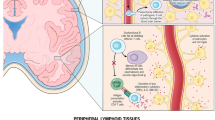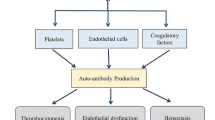Abstract
Background
Dengue virus (DENV) infection is a serious public health issue without specific treatment. We examined the potential immunomodulatory effects of leflunomide, a dihydroorotate dehydrogenase inhibitor commonly prescribed for arthritis, in DENV-stimulated monocyte-derived dendritic cells (mo-DCs).
Methods
mo-DCs were prepared from purified monocytes. Cytokine and chemokine concentrations were determined by enzyme-linked immunosorbent assay. Expression of cell surface markers or viral E protein was measured by flow cytometry. The activation of transcription factors and kinases was determined by electrophoretic mobility shift assays, Western blotting, or immunoprecipitation kinase assays. Chemotaxis assays were used to determine cell migration.
Results
Leflunomide at therapeutic concentrations inhibited cytokine and chemokine production from DENV-infected mo-DCs. Leflunomide suppressed mo-DC maturation by downregulating the expression of both CD80 and CD86. In addition, leflunomide inhibited DENV-induced mo-DC migration and mo-DC response to chemoattractants CCL19 and CCL21. Inhibition of mo-DC migration was likely due to the suppression of CCR7 expression on mo-DCs. These events were associated with the suppression of nuclear factor kappa B and activator protein-1 signaling pathways by leflunomide.
Conclusions
Leflunomide preserves immunosuppressive effects, inhibiting activation of DENV-stimulated mo-DCs. Leflunomide may be helpful in the development of therapeutics for DENV infection.









Similar content being viewed by others
Abbreviations
- DENV:
-
dengue virus
- mo-DCs:
-
dendritic cells
- DHF:
-
dengue hemorrhagic fever
- DSS:
-
dengue shock syndrome
- DHODH:
-
dihydroorotate dehydrogenase
- IKK:
-
IκB kinase
- NF-κB:
-
nuclear factor kappa B
- MAPK:
-
mitogen-activated protein kinase
- JNK:
-
c-Jun N-terminal kinase
- ERK:
-
extracellular signal-regulated kinase
- AP-1:
-
activator protein-1
- MCP-1:
-
monocyte chemoattractant protein-1
- MIP-1α:
-
macrophage inflammatory protein-1α
- RANTES:
-
regulated upon activation, normal T cell expressed and secreted
References
Guzman MG, Kouri G. Dengue and dengue hemorrhagic fever in the Americas: lessons and challenges. J Clin Virol. 2003;27:1–13.
Lin YW, Wang KJ, Lei HY, et al. Virus replication and cytokine production in dengue virus-infected human B lymphocytes. J Virol. 2002;76:12242–9.
King CA, Anderson R, Marshall JS. Dengue virus selectively induces human mast cell chemokine production. J Virol. 2002;76:8408–19.
Jessie K, Fong MY, Devi S, et al. Localization of dengue virus in naturally infected human tissues, by immunohistochemistry and in situ hybridization. J Infect Dis. 2004;189:1411–8.
de Macedo FC, Nicol AF, Cooper LD, et al. Histologic, viral, and molecular correlates of dengue fever infection of the liver using highly sensitive immunohistochemistry. Diagn Mol Pathol. 2006;15:223–8.
Warke RV, Becerra A, Zawadzka A, et al. Efficient dengue virus (DENV) infection of human muscle satellite cells upregulates type I interferon response genes and differentially modulates MHC I expression on bystander and DENV-infected cells. J Gen Virol. 2008;89:1605–15.
Wu WL, Ho LJ, Chang DM, et al. Triggering of DC migration by dengue virus stimulation of COX-2-dependent signaling cascades in vitro highlights the significance of these cascades beyond inflammation. Eur J Immunol. 2009;39:3413–22.
Ho LJ, Wang JJ, Shaio MF, et al. Infection of human dendritic cells by dengue virus causes cell maturation and cytokine production. J Immunol. 2001;166:1499–506.
Tassaneetrithep B, Burgess TH, Granelli-Piperno A, et al. DC-SIGN (CD209) mediates dengue virus infection of human dendritic cells. J Exp Med. 2003;197:823–9.
Luplertlop N, Misse D, Bray D, et al. Dengue-virus-infected dendritic cells trigger vascular leakage through metalloproteinase overproduction. EMBO Rep. 2006;7:1176–81.
Green S, Vaughn DW, Kalayanarooj S, et al. Early immune activation in acute dengue illness is related to development of plasma leakage and disease severity. J Infect Dis. 1999;179:755–62.
Juffrie M, van Der Meer GM, Hack CE, et al. Inflammatory mediators in dengue virus infection in children: interleukin-8 and its relationship to neutrophil degranulation. Infect Immun. 2000;68:702–7.
Chau TN, Quyen NT, Thuy TT, et al. Dengue in Vietnamese infants—results of infection-enhancement assays correlate with age-related disease epidemiology, and cellular immune responses correlate with disease severity. J Infect Dis. 2008;198:516–24.
Sierra B, Perez AB, Vogt K, et al. MCP-1 and MIP-1alpha expression in a model resembling early immune response to dengue. Cytokine. 2010;52:175–83.
Dejnirattisai W, Duangchinda T, Lin CL, et al. A complex interplay among virus, dendritic cells, T cells, and cytokines in dengue virus infections. J Immunol. 2008;181:5865–74.
Martina BE, Koraka P, Osterhaus AD. Dengue virus pathogenesis: an integrated view. Clin Microbiol Rev. 2009;22:564–81.
Noble CG, Chen YL, Dong H, et al. Strategies for development of dengue virus inhibitors. Antiviral Res. 2010;85:450–62.
Murrell S, Wu SC, Butler M. Review of dengue virus and the development of a vaccine. Biotechnol Adv. 2011;29:239–47.
Cherwinski HM, Cohn RG, Cheung P, et al. The immunosuppressant leflunomide inhibits lymphocyte proliferation by inhibiting pyrimidine biosynthesis. J Pharmacol Exp Ther. 1995;275:1043–9.
Fairbanks LD, Bofill M, Ruckemann K, et al. Importance of ribonucleotide availability to proliferating T-lymphocytes from healthy humans. Disproportionate expansion of pyrimidine pools and contrasting effects of de novo synthesis inhibitors. J Biol Chem. 1995;270:29682–9.
Nandi P, Kingsley GH, Scott DL. Disease-modifying antirheumatic drugs other than methotrexate in rheumatoid arthritis and seronegative arthritis. Curr Opin Rheumatol. 2008;20:251–6.
Wu JK, Harris MT. Use of leflunomide in the treatment of polyomavirus BK-associated nephropathy. Ann Pharmacother. 2008;42:1679–85.
Schlapfer E, Fischer M, Ott P, et al. Anti-HIV-1 activity of leflunomide: a comparison with mycophenolic acid and hydroxyurea. AIDS. 2003;17:1613–20.
Knight DA, Hejmanowski AQ, Dierksheide JE, et al. Inhibition of herpes simplex virus type 1 by the experimental immunosuppressive agent leflunomide. Transplantation. 2001;71:170–4.
Waldman WJ, Knight DA, Lurain NS, et al. Novel mechanism of inhibition of cytomegalovirus by the experimental immunosuppressive agent leflunomide. Transplantation. 1999;68:814–25.
Avery RK. Update in management of ganciclovir-resistant cytomegalovirus infection. Curr Opin Infect Dis. 2008;21:433–7.
Davis IC, Lazarowski ER, Chen FP, et al. Post-infection A77-1726 blocks pathophysiologic sequelae of respiratory syncytial virus infection. Am J Respir Cell Mol Biol. 2007;37:379–86.
Ho LJ, Hung LF, Weng CY, et al. Dengue virus type 2 antagonizes IFN-alpha but not IFN-gamma antiviral effect via down-regulating Tyk2-STAT signaling in the human dendritic cell. J Immunol. 2005;174:8163–72.
Stein DA, Huang CY, Silengo S, et al. Treatment of AG129 mice with antisense morpholino oligomers increases survival time following challenge with dengue 2 virus. J Antimicrob Chemother. 2008;62:555–65.
Rothwell C, Lebreton A, Young Ng C, et al. Cholesterol biosynthesis modulation regulates dengue viral replication. Virology. 2009;389:8–19.
Cheng SM, Yang SP, Ho LJ, et al. Down-regulation of c-jun N-terminal kinase-activator protein-1 signaling pathway by Ginkgo biloba extract in human peripheral blood T cells. Biochem Pharmacol. 2003;66:679–89.
Ho LJ, Juan TY, Chao P, et al. Plant alkaloid tetrandrine downregulates IkappaBalpha kinases-IkappaBalpha-NF-kappaB signaling pathway in human peripheral blood T cell. Br J Pharmacol. 2004;143:919–27.
Scandella E, Men Y, Legler DF, et al. CCL19/CCL21-triggered signal transduction and migration of dendritic cells requires prostaglandin E2. Blood. 2004;103:1595–601.
Ho LJ, Shaio MF, Chang DM, et al. Infection of human dendritic cells by dengue virus activates and primes T cells towards Th0-like phenotype producing both Th1 and Th2 cytokines. Immunol Invest. 2004;33:423–37.
Bosch I, Xhaja K, Estevez L, et al. Increased production of interleukin-8 in primary human monocytes and in human epithelial and endothelial cell lines after dengue virus challenge. J Virol. 2002;76:5588–97.
Chen YC, Wang SY. Activation of terminally differentiated human monocytes/macrophages by dengue virus: productive infection, hierarchical production of innate cytokines and chemokines, and the synergistic effect of lipopolysaccharide. J Virol. 2002;76:9877–87.
Libraty DH, Pichyangkul S, Ajariyakhajorn C, et al. Human dendritic cells are activated by dengue virus infection: enhancement by gamma interferon and implications for disease pathogenesis. J Virol. 2001;75:3501–8.
Lin CF, Chiu SC, Hsiao YL, et al. Expression of cytokine, chemokine, and adhesion molecules during endothelial cell activation induced by antibodies against dengue virus nonstructural protein 1. J Immunol. 2005;174:395–403.
Rozman B. Clinical pharmacokinetics of leflunomide. Clin Pharmacokinet. 2002;41:421–30.
Josephson MA, Gillen D, Javaid B, et al. Treatment of renal allograft polyoma BK virus infection with leflunomide. Transplantation. 2006;81:704–10.
Bernhoff E, Tylden GD, Kjerpeseth LJ, et al. Leflunomide inhibition of BK virus replication in renal tubular epithelial cells. J Virol. 2010;84:2150–6.
Hoffmann HH, Kunz A, Simon VA, et al. Broad-spectrum antiviral that interferes with de novo pyrimidine biosynthesis. Proc Natl Acad Sci USA. 2011;108:5777–82.
Spain-Santana TA, Marglin S, Ennis FA, et al. MIP-1 alpha and MIP-1 beta induction by dengue virus. J Med Virol. 2001;65:324–30.
Chen JP, Lu HL, Lai SL, et al. Dengue virus induces expression of CXC chemokine ligand 10/IFN-gamma-inducible protein 10, which competitively inhibits viral binding to cell surface heparan sulfate. J Immunol. 2006;177:3185–92.
Mathew A, Rothman AL. Understanding the contribution of cellular immunity to dengue disease pathogenesis. Immunol Rev. 2008;225:300–13.
Screaton G, Mongkolsapaya J. T cell responses and dengue haemorrhagic fever. Novartis Found Symp. 2006;277:164–71. discussion 71–6, 251–3.
Rothman AL. Cellular immunology of sequential dengue virus infection and its role in disease pathogenesis. Curr Top Microbiol Immunol. 2010;338:83–98.
MartIn-Fontecha A, Sebastiani S, Hopken UE, et al. Regulation of dendritic cell migration to the draining lymph node: impact on T lymphocyte traffic and priming. J Exp Med. 2003;198:615–21.
Ohl L, Mohaupt M, Czeloth N, et al. CCR7 governs skin dendritic cell migration under inflammatory and steady-state conditions. Immunity. 2004;21:279–88.
Ceballos-Olvera I, Chavez-Salinas S, Medina F, et al. JNK phosphorylation, induced during dengue virus infection, is important for viral infection and requires the presence of cholesterol. Virology. 2010;396:30–6.
Moore F, Buonocore S, Aksoy E, et al. An alternative pathway of NF-kappaB activation results in maturation and T cell priming activity of dendritic cells overexpressing a mutated IkappaBalpha. J Immunol. 2007;178:1301–11.
Isomura I, Tsujimura K, Morita A. Antigen-specific peripheral tolerance induced by topical application of NF-kappaB decoy oligodeoxynucleotide. J Invest Dermatol. 2006;126:97–104.
Pietila TE, Veckman V, Lehtonen A, et al. Multiple NF-kappaB and IFN regulatory factor family transcription factors regulate CCL19 gene expression in human monocyte-derived dendritic cells. J Immunol. 2007;178:253–61.
Jimenez F, Quinones MP, Martinez HG, et al. CCR2 plays a critical role in dendritic cell maturation: possible role of CCL2 and NF-kappa B. J Immunol. 2010;184:5571–81.
Moutaftsi M, Brennan P, Spector SA, et al. Impaired lymphoid chemokine-mediated migration due to a block on the chemokine receptor switch in human cytomegalovirus-infected dendritic cells. J Virol. 2004;78:3046–54.
Korn T, Magnus T, Toyka K, et al. Modulation of effector cell functions in experimental autoimmune encephalomyelitis by leflunomide—mechanisms independent of pyrimidine depletion. J Leukoc Biol. 2004;76:950–60.
Stuhlmeier KM. Effects of leflunomide on hyaluronan synthases (HAS): NF-kappa B-independent suppression of IL-1-induced HAS1 transcription by leflunomide. J Immunol. 2005;174:7376–82.
Kirsch BM, Zeyda M, Stuhlmeier K, et al. The active metabolite of leflunomide, A77 1726, interferes with dendritic cell function. Arthritis Res Ther. 2005;7:R694–703.
Witt MN, Braun GS, Ihrler S, et al. Occurrence of HSV-1-induced pneumonitis in patients under standard immunosuppressive therapy for rheumatic, vasculitic, and connective tissue disease. BMC Pulm Med. 2009;9:22.
Acknowledgements
This report was supported by a grant from the Institutional Collaboration Projects raised by both Chi Mei Medical Center and National Defense Medical Center (CMNDMC99 and CMNDMC10008) as well as from Institute of Preventive Medicine, National Defense Medical Center. The authors’ work was supported in part by grants from the National Science Council (NSC 96-2314-B-016-015-MY3, NSC 96-2314-B-400-003-MY2, and NSC 98-2314-B-400-002-MY3).
Competing Interests
The authors declare that they have no competing interests.
Author information
Authors and Affiliations
Corresponding author
Rights and permissions
About this article
Cite this article
Wu, WL., Ho, LJ., Chen, PC. et al. Immunosuppressive Effects and Mechanisms of Leflunomide in Dengue Virus Infection of Human Dendritic Cells. J Clin Immunol 31, 1065–1078 (2011). https://doi.org/10.1007/s10875-011-9578-7
Received:
Accepted:
Published:
Issue Date:
DOI: https://doi.org/10.1007/s10875-011-9578-7




